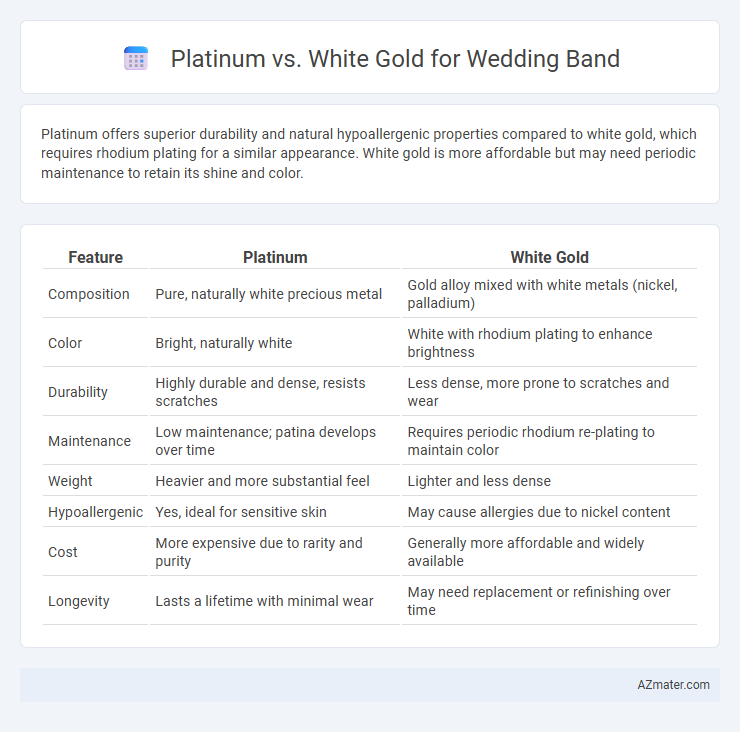Platinum offers superior durability and natural hypoallergenic properties compared to white gold, which requires rhodium plating for a similar appearance. White gold is more affordable but may need periodic maintenance to retain its shine and color.
Table of Comparison
| Feature | Platinum | White Gold |
|---|---|---|
| Composition | Pure, naturally white precious metal | Gold alloy mixed with white metals (nickel, palladium) |
| Color | Bright, naturally white | White with rhodium plating to enhance brightness |
| Durability | Highly durable and dense, resists scratches | Less dense, more prone to scratches and wear |
| Maintenance | Low maintenance; patina develops over time | Requires periodic rhodium re-plating to maintain color |
| Weight | Heavier and more substantial feel | Lighter and less dense |
| Hypoallergenic | Yes, ideal for sensitive skin | May cause allergies due to nickel content |
| Cost | More expensive due to rarity and purity | Generally more affordable and widely available |
| Longevity | Lasts a lifetime with minimal wear | May need replacement or refinishing over time |
Introduction to Platinum and White Gold
Platinum, a naturally white and dense metal, offers exceptional durability and hypoallergenic properties, making it a premium choice for wedding bands. White gold, an alloy typically composed of gold mixed with palladium or nickel, is coated with rhodium to enhance its bright white appearance and affordability. Both metals are popular for their elegant look and long-lasting allure in wedding jewelry.
Composition and Material Differences
Platinum is a naturally white metal composed mainly of pure platinum (95% or higher), renowned for its density, durability, and hypoallergenic properties, making it ideal for sensitive skin. White gold is an alloy typically made from yellow gold mixed with metals like palladium, nickel, or silver, then coated with rhodium to achieve its white appearance, which requires periodic re-plating to maintain its shine. The fundamental distinction lies in platinum's purity and natural whiteness versus white gold's alloy composition and reliance on plating for color and resistance.
Durability and Strength Comparison
Platinum is significantly denser and more durable than white gold, making it highly resistant to scratches and wear over time, which suits daily wear for wedding bands. White gold, typically alloyed with stronger metals like palladium or nickel and coated with rhodium, offers good strength but requires periodic re-plating to maintain its finish. The inherent durability of platinum ensures it maintains its luster and structural integrity longer, while white gold provides a more affordable option with moderate strength.
Color and Appearance Over Time
Platinum maintains its natural white sheen and resists tarnishing, making it an ideal choice for wedding bands that retain their luster over time without needing frequent polishing. White gold often requires rhodium plating to achieve its bright white look, which may wear off over years, revealing a slightly yellowish tint underneath. For long-term appearance, platinum offers a durable, naturally white finish, while white gold demands more upkeep to preserve its initial color and shine.
Maintenance and Care Requirements
Platinum wedding bands require minimal maintenance due to their naturally durable and hypoallergenic properties, developing a unique patina over time that can be polished if desired. White gold bands, coated with rhodium for brightness, need regular re-plating every 1-2 years to maintain their lustrous white finish and prevent yellowing. Both metals benefit from gentle cleaning with mild soap and water, but white gold demands more frequent professional upkeep to preserve its appearance.
Hypoallergenic Properties
Platinum boasts superior hypoallergenic properties compared to white gold, as it is a naturally pure metal that rarely causes allergic reactions, making it an ideal choice for sensitive skin. White gold often contains nickel or other alloys that can trigger allergies or irritations in some individuals. Couples prioritizing comfort and safety frequently opt for platinum wedding bands to minimize the risk of skin sensitivity and maintain long-term wearability.
Cost and Value Analysis
Platinum wedding bands typically cost 30-50% more than white gold due to their rarity, density, and naturally white hue that requires no plating. White gold bands often require rhodium plating to maintain their bright finish, adding ongoing maintenance costs that platinum does not incur. Over time, platinum's durability and hypoallergenic properties provide greater long-term value despite its higher initial price, making it a preferred choice for those seeking longevity and investment in their wedding band.
Weight and Comfort on the Finger
Platinum wedding bands are denser and heavier than white gold, providing a substantial feel on the finger that many wearers find luxurious and durable. White gold is lighter and often coated with rhodium, offering a smoother and more comfortable fit, especially for those who prefer less weight on their hand. Both metals ensure lasting comfort, but platinum's weight can enhance the sense of presence while white gold delivers a lighter, more flexible wear experience.
Resizing and Repair Considerations
Platinum wedding bands offer superior durability and can be resized multiple times without compromising metal integrity, making them ideal for long-term wear and adjustments. White gold, while easier to resize due to its softer alloy composition, may require replating with rhodium after resizing to maintain its bright white appearance. Repairing platinum is generally more straightforward as it withstands soldering and reshaping better than white gold, which is more prone to surface wear and color fading during repairs.
Choosing the Best Option for Your Lifestyle
Platinum offers exceptional durability and hypoallergenic properties, ideal for those with sensitive skin or an active lifestyle requiring a scratch-resistant wedding band. White gold, alloyed with stronger metals and often coated with rhodium, provides a more affordable and customizable option but may need periodic re-plating to maintain its luster. Selecting between platinum and white gold depends on balancing budget, maintenance preferences, and the daily wear demands of your lifestyle.

Infographic: Platinum vs White Gold for Wedding Band
 azmater.com
azmater.com